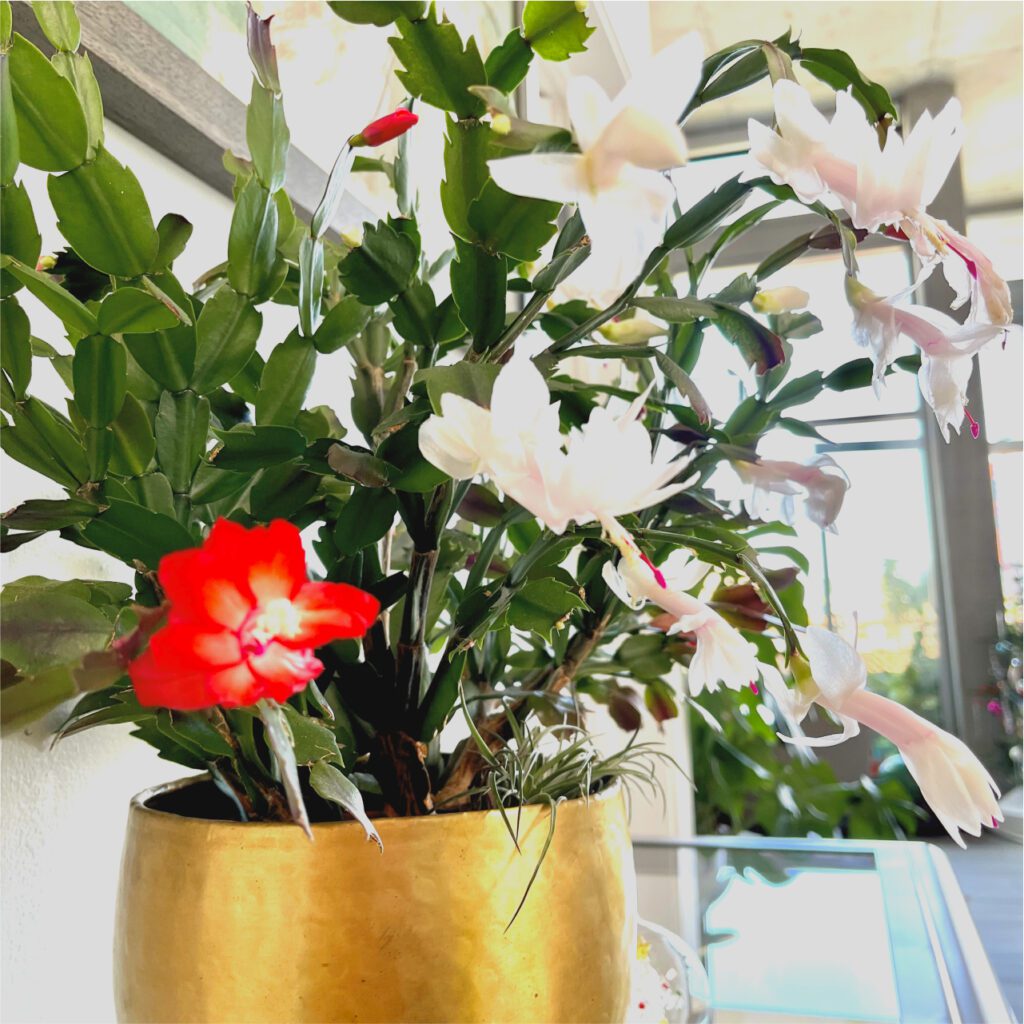Are you looking for the best indoor plants to bring winter cheer to your home and to your friends and families? If yes, you’ve come to the right place as we put together a list of our nine proven favorites. These plants are perfect for gifts and decorating your home during the holiday season.
The holidays are a time when we all come together to celebrate with family and friends. It’s also a great opportunity to bring cheer into your home by decorating with festive plants. There are many different types of plants that can be used for holiday decor, each with its own unique charm. In this blog post, we will discuss some of our favorite plants to use for winter decorating. We will also provide tips on how to care for them so that they can last for years to come!
Keep reading for more information on each plant, and be sure to check out our tips for taking care of them!
The Short List: From Amaryllis to Poinsettias, we’ve got you covered.
1. Poinsettia
The poinsettia is a festive favorite amongst many available cheerful holiday plants. This plant brings beautiful red color and life to any décor. The poinsettia plant is known to have large, bright red bracts, with small yellow flowers, and contrasting dark green foliage. Poinsettias do best in bright, indirect light and do not like cold temperatures. Water when the soil feels dry to the touch and fertilize every two weeks with a balanced houseplant fertilizer for best results.
2. Christmas Cactus
A Christmas cactus is a great choice for adding a festive touch to your home during the holidays. This easy-to-care-for and rewarding plant features arching stems of flattened, segmented leaves. This plant also produces blooms that feature delicate flowers in the winter. Place it near an east-facing window to get plenty of indirect light and keep the soil slightly moist but never soggy. Cut back on watering after flowering has finished, but don’t let it dry out completely.
3. Amaryllis
Big, bold amaryllis blooms make this a stunning plant for any holiday celebration. They come in shades of pink, red, orange, white, and more! Plant them crown side down in a well-draining potting mix about 2 inches deep in a container. Water regularly until growth appears then reduce watering slightly until buds form. Place them in bright indirect sunlight for best results.
4. Cyclamen
With its sweetly fragrant blooms of white or pink petals surrounding a yellow center, Cyclamen is an elegant addition to your holiday décor that will last well into the spring season! Place them in indirect light away from drafts. Water only when the top inch of soil is dry so they don’t become soggy. Fertilize monthly with liquid houseplant food while actively growing (usually October through April).
5. Norfolk Island Pine
Norfolk Island pine makes an attractive living holiday decoration even if you don’t have room for a big tree! Keep it away from drafts or heat sources like radiators. Water when the top inch of soil is dry and mist weekly. Give it some slow-release fertilizer twice per year to keep it happy and healthy!
6. Paperwhite Narcissus
Paperwhites are a popular bulb that needs no special treatment. Just plant them in soil and water. No need to fertilize as paperwhites get all their nutrition from their bulbs! They will bloom within 4-6 weeks with beautiful clusters of white star-shaped flowers perfect for any holiday display!
7. Rosemary Topiary Tree
Perfectly shaped rosemary trees make for delightful living Christmas Plants! These aromatic evergreens can be used fresh or dried as decorations, or even used as cooking herbs! Provide them with lots of light (they can handle direct sun). Feed with diluted liquid fertilizer once per month during the active growing season (spring/summer). Prune back branches as needed to maintain the desired shape. And don’t forget to re-pot every couple of years or as needed!
8. Kalanchoe
This festive succulent shows off colorful blooms around Christmas time perfect for decorating mantels or tablescapes. Place this easy-care plant where it will get plenty of bright indirect light such as on windowsills. Water only when the soil is completely dry otherwise risks root rot. Fertilize once during the spring/summer season. No need for the rest of the time since kalanchoes typically go dormant over winter months anyway!
9. Mistletoe Cactus
This festive tropical cactus displays beautiful blooms around Christmas time making it an excellent choice. They need lots of bright light while avoiding direct afternoon sun which can cause burning. Keep evenly moist by watering weekly, or once the top inch dries out. Fertilize lightly once per month during the growing season using a diluted fertilizer.
Say NO to buying a live, potted Christmas tree this holiday season, and consider these “indoor” plants instead.
Holiday decorating with plants can be challenging since not all plants sold as “holiday plants” can live indoors for long periods of time, like a live, potted Christmas tree. Evergreen trees used as Christmas trees are full sun plants that always do better in the ground. Their roots need room to grow deeper in order to establish a solid foundation to support the tree. So if you decide to adopt a live, potted Christmas tree this season, plan on a temporary spot in your home where it will get lots of light. As soon as the holidays are over, then plant it outdoors in a permanent spot.
An in-depth look at the best Christmas Plants
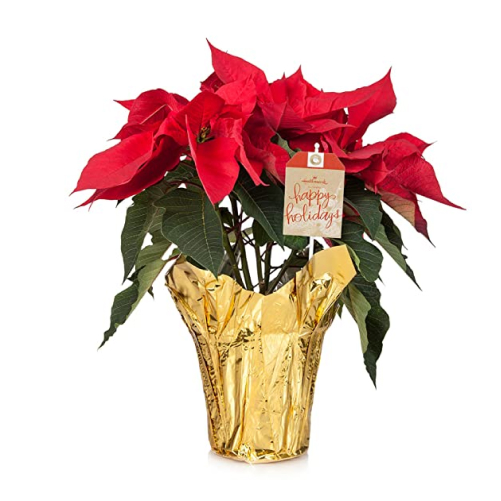

1. Poinsettia:
Poinsettias are traditional Christmas plants that now come in a variety of colors and styles. The traditional poinsettia is red, however, over the years growers have developed many different varieties. These brightly colored bracts range from pink and white to yellow and orange. Some even have multi-colored, bicolor, and speckled bracts that can look like confetti cake!
There are also several varieties of poinsettia plants with different leaf shapes, such as the classic star shape or even more exotic foliage like the primrose shape. A wide variety of textures are also available for poinsettias. Some types have shiny smooth leaves while others have fuzzy velvety surfaces.
Different petal shapes can also be found among poinsettias as well. Some feature long slender bracts while others offer large ruffled bracts with fancy frilly edges. With so many different colors, styles, shapes, and textures available it’s no wonder why poinsettias remain one of the most beloved holiday plants each year.
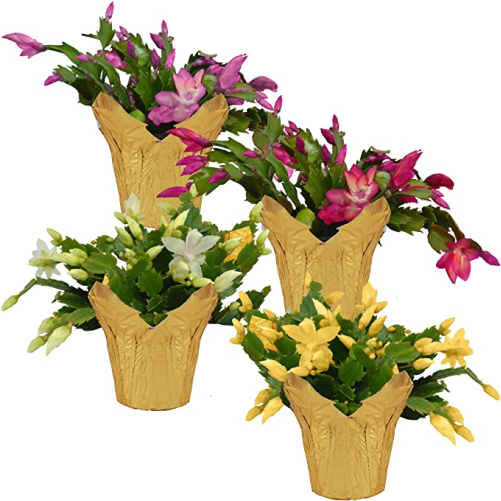

2. Christmas Cactus:
The Christmas cactus, or Schlumbergera truncata, is a tropical species of cactus native to southeastern Brazil. It is an evergreen flowering cactus that blooms during the winter months and typically features vibrant shades of red, pink, and white flowers. The stems of this plant are somewhat segmented and will often feature a deep green or even a purplish color. The leaves grow in groups of three that are either flat or slightly curved inwards.
The diversity of colors and styles available when it comes to Christmas cacti is truly remarkable. Popular colors include bright pink and scarlet red. Some may even feature deeper hues like maroon, magenta, purple, or orange. Additionally, there are also bi-colored varieties with petals featuring two different colors such as white with pink tips or yellow with red accents.
Christmas cacti are low maintenance and easy to care for, if you can handle snake plants this is up your alley. They require little care and attention and can be quite forgiving houseplants. They will also bloom each year on their own without any special care or attention. They are an excellent option for novice gardeners who want something beautiful yet low maintenance!
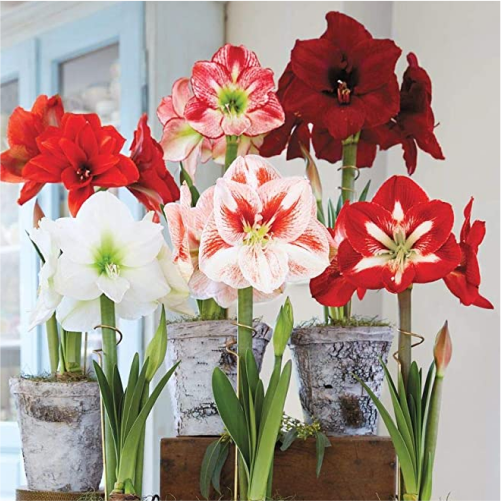

3. Amaryllis:
Amaryllis is one of the most popular flowering plants or best Christmas plants. It is widely grown for its vibrant colors and striking flower styles. Varieties of amaryllis come in a wide range of colors, from white and pink to orange, yellow, red, purple, and even green. There are even some varieties with bicolor or striped petals. The shapes of the flowers vary too! They can be single-petal or multi-petal, trumpet-shaped flowers, star-shaped anemone flowers, and more. Amaryllis can grow up to 16 inches tall and their blooms can reach 8 inches across. Amaryllis is a great choice for adding a splash of color to your home and blooms within 6–8 weeks after planting indoors.
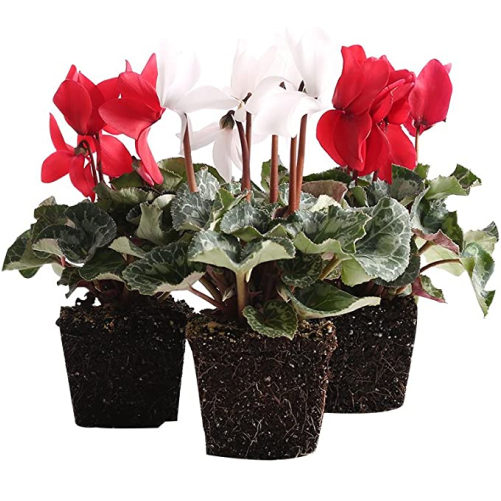

4. Cyclamen:
Cyclamen can be found in varieties of white, pink, lavender, magenta, red, orange, and purple. Not only do they come in these beautiful hues but also in different shapes such as single or double flowers and even some that look like butterflies. The most popular color is usually the deep purples and pinks which are incredibly striking when nestled among bright green foliage.
The heart-shaped leaves of cyclamen have unique marbling patterns that can vary depending on the type you choose. They range from plain deep green to intricate silver-grey swirls or spots. Cyclamens make great houseplants due to their ability to thrive in cooler temperatures with a moderate amount of water. They will reward you with their stunning flowers during winter months when other plants are dormant.
Additionally, cyclamen rhizomes contain medicinal properties which makes them even more desirable for gardeners and enthusiasts alike!
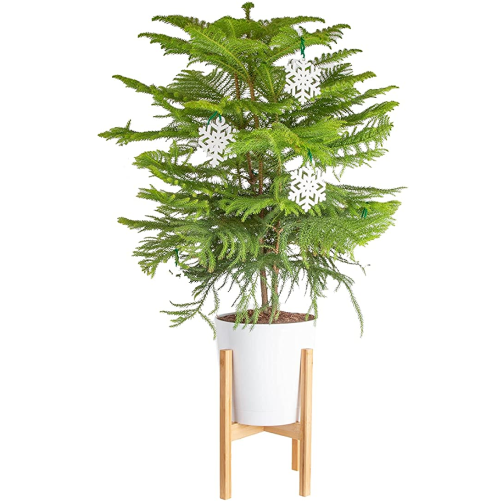

5. Norfolk Island Pine:
Norfolk Island pines are actually not a true pine tree, they are members of a pre-historic family of conifers Araucariaceae. They are part of an incredibly diverse and widespread plant family during the Jurassic and Cretaceous time periods.
These coniferous trees are native to the South Pacific island of Norfolk Island, located between Australia and New Zealand. These attractive trees have been used in landscaping around the world due to their attractive pyramidal shape and bright green foliage. These robust plants can reach heights of up to 200 feet and live for hundreds of years.
The trunk is typically straight and slender with branches extending from a central leader in tiers. The leaves are long, flat needles that grow in pairs along the branches, giving them a feathery appearance.
In temperate climates, the Norfolk Island pine is often used as an indoor houseplant or container plant. As a houseplant, it grows best in moist soil and bright light, but also tolerates partial shade.
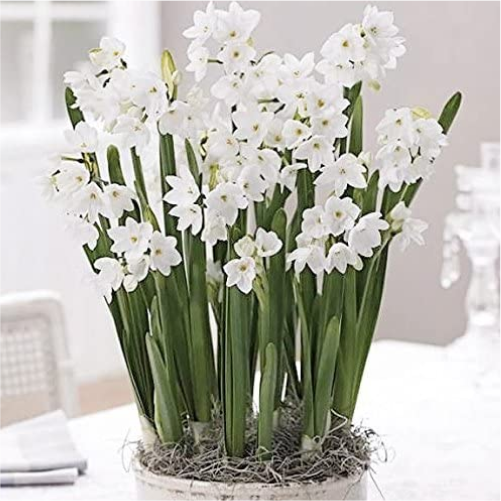

6. Paperwhite Narcissus:
Paperwhite narcissus, also known as Narcissus papyraceus, is a species of flowering plant native to the Mediterranean region. It is a perennial bulbous herbaceous plant that typically grows up to 30 cm tall and has fragrant white flowers with yellow centers.
The flowers bloom in winter or spring and are often used in cut flower arrangements, as well as for their unique scent. Paperwhite narcissus is an excellent choice for providing early-season color in any garden or landscape design.
Planting multiple clusters of paperwhite narcissus bulbs can create a beautiful display of blooms. The bulbs do best when planted 1-2 inches deep in well-drained soil and should be watered regularly throughout their growth cycle. They also prefer full sun but will tolerate partial shade, making them suitable for growing indoors or outdoors.
With proper care, they can be enjoyed for many years and will naturalize over time if left undisturbed. Since the bulbs multiply rapidly, they can be divided every few years to help keep their numbers managed while still providing plenty of blooms each year. Paperwhite narcissus brings beauty to any space and makes delightful gifts for friends and loved ones alike!
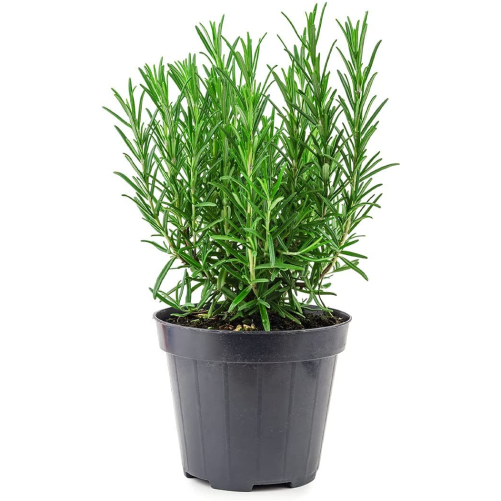

7. Rosemary Topiary Tree:
The Rosemary Topiary Tree is an attractive and unique addition to any garden or outdoor area. These trees are native to the Mediterranean and are actually a type of herb rather than a true tree. The leaves provide a silvery green hue with a very pleasant smell when brushed against. They also grow quite quickly if properly cared for.
Rosemary topiary trees can reach heights of up to 4 feet tall, though most are sold at about a foot tall. Pruning and trimming need to be done regularly in order to maintain the desired shape and size of these topiaries.
Rosemary is drought-tolerant once established but will need regular watering during dry spells. Rosemary topiary trees should be fertilized at least once a year during springtime. Properly cared for, these unique ornamental plants can bring beauty and visual interest to any space while also providing a scent that reminds us of summertime in the beautiful Mediterranean!
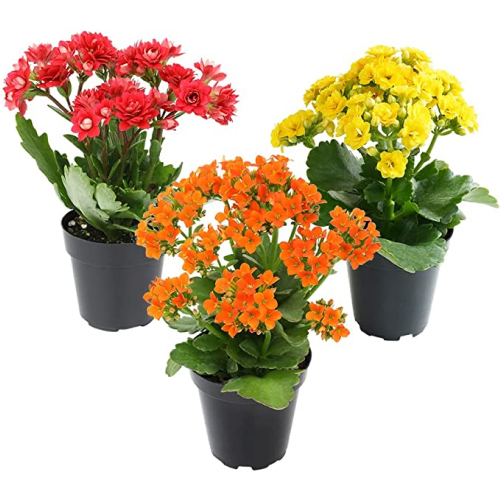

8. Kalanchoe:
Kalanchoe is an incredibly diverse flowering plant that is native to the tropical and subtropical regions of Eurasia and Africa. There are around 125 different species in this genus, all with unique features.
In general, they have thick, fleshy leaves and colorful flowers of various shapes and sizes. Some of the most common species of Kalanchoe include the Kalanchoe Blossfeldiana, which has bright red or pink flowers.
The Kalanchoe Daigremontiana, produces a cluster of small orange or white flowers. And the Kalanchoe Dhyrsiflora produces yellow star-shaped blossoms. Other popular varieties include Kalanchoe Pinnata, which has deep purple blooms, Kalanchoe Flammea, whose delicate yellow flowers look like flame-like petals, and Kalanchoe Beharensis, whose vibrant pink blooms form a bushy dome shape.
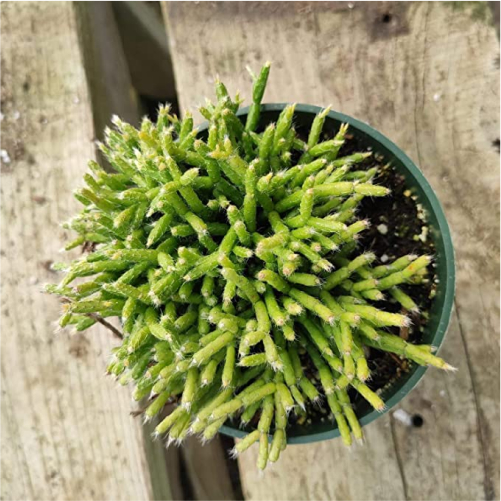

9. Mistletoe Cactus:
The Mistletoe Cactus, or Rhipsalis Baccifera, is a tropical plant that belongs to the Cactaceae family. Native to Central and South America, it grows in wooded areas and prefers humid climates. The Mistletoe Cactus has long thin stems which form an arching habit, creating its iconic fan-like shape.
The leaves are round and slender, and come in a wide variety of colors that range from yellow-greens to reds and purples, with new growth starting as bright green. The flowers bloom at night and have a pleasant scent. They are white or pink with yellow centers followed by edible white berries.
This cactus requires bright partial shade with the soil moist but can handle dry spells between watering sessions. When grown indoors it should be kept away from windows since too much direct sun can burn its delicate leaves. To ensure healthy growth it needs good drainage with plenty of organic matter in the potting soil.
I hope you have enjoyed reading about my holiday favorites and that they bring you and your family years of joy!
Remember winter plant decor doesn’t have to be dusty faux plastic leaves. You can keep your holiday decor alive and active year-round. Also to breathe a little easier this winter, be sure to read my previous post 5 EASY WAYS TO IMPROVE HUMIDITY FOR YOUR HOUSE PLANTS.
